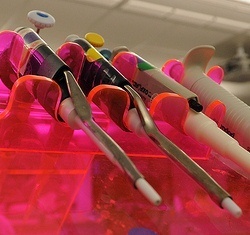
We all know that money is dirty, but did you know that you could have cocaine sitting in your wallet or purse.
A local high school student has teamed up with a lab at Notre Dame to search out the drug on local money, the results are a bit shocking.
“This is the structure of a cocaine molecule,” says Stacie Skwarcan a Marian High School Senior.
Stacie Skwarcan, is a Senior at Marian High School and she knows more about cocaine than most folks.
“Cocaine is an organic contaminant because it has carbon in it,” says Skwarcan.
And she is using that knowledge to locate the drug on money, right here in South Bend
“Initially I was pretty surprised to find out that you could detect cocaine on money but as I did more research and looked into how cocaine is actually used, it makes sense to find cocaine on money,” says Skwarcan.
Her research is being done here, at Notre Dame as part of a research class that puts high school students in working labs. Bill Boggess, is working with her and he is also surprised by the findings.
“I am surprised first of all at the prevalence, it is literally on every bill that we have touched and worked with,” says Bill Boggess the Director of Mass Spectrometry & Proteomics Facility at Notre Dame.
To find the drug, a solvent is used to strip all of the organic compounds off of the money. That liquid is then put into machines to help identify what is on the bill.
“It is a separation device, coupled to a detector,” explains Boggess. ”The LC is Liquid Chromatograph that separates components in a mixture and each of those components, once it is separated is identified by the mass spectrometer.”
The bill we tested had just over 1 microgram of cocaine on it, and that is one of the lowest amounts they have found.
“I am surprised first of all at the prevalence, it is literally on every bill that we have touched and worked with and the amount, some of these bills on average we are finding about 5 micro grams of cocaine,” says Boggess.
But some have had even more.
“One bill here has 22 1/2 micrograms of cocaine,” says Skwarcan. “I would have never guessed that this bill had come into direct contact with cocaine.”
“What we think is that recreational users use the bills to ingest, to snort the cocaine,” says Boggess. “So that bill has come into direct contact with the cocaine, but not all bills are used to ingest cocaine what happens is that the bill that has been used to snort cocaine gets put into circulation.”
Those bills contaminate other bills, and machines spread it from there.
“That would result from money being put through ATMs and money counters and being circulated basically,” says Skwarcan.
While the results show it on every single bill tested, there is little reason to be concerned.
5 micrograms is a very small amount relative to what recreation drug users might ingest or what might be deemed harmful as accidental exposure.
While a kilogram of cocaine has a street value of close to $100,000, the average amount of cocaine found on these bills is worth less than 1 penny.
“It is not in horribly large amounts that people should be very concerned but it is just surprising initially to find out it is on money,” says Skwarcan.
There were some other interesting discoveries in their research. While cocaine made up about 12 percent of the contamination on the money, the other contaminants were compounds used in hand soaps and antibacterial hand sanitizers.
And congratulations are due; Stacie was recently named the Junior Scientist of the Year, by the Indiana Junior Academy of Science.
Originally published by at WNDU.com on November 21, 2012. Read the original story on WNDU.com.